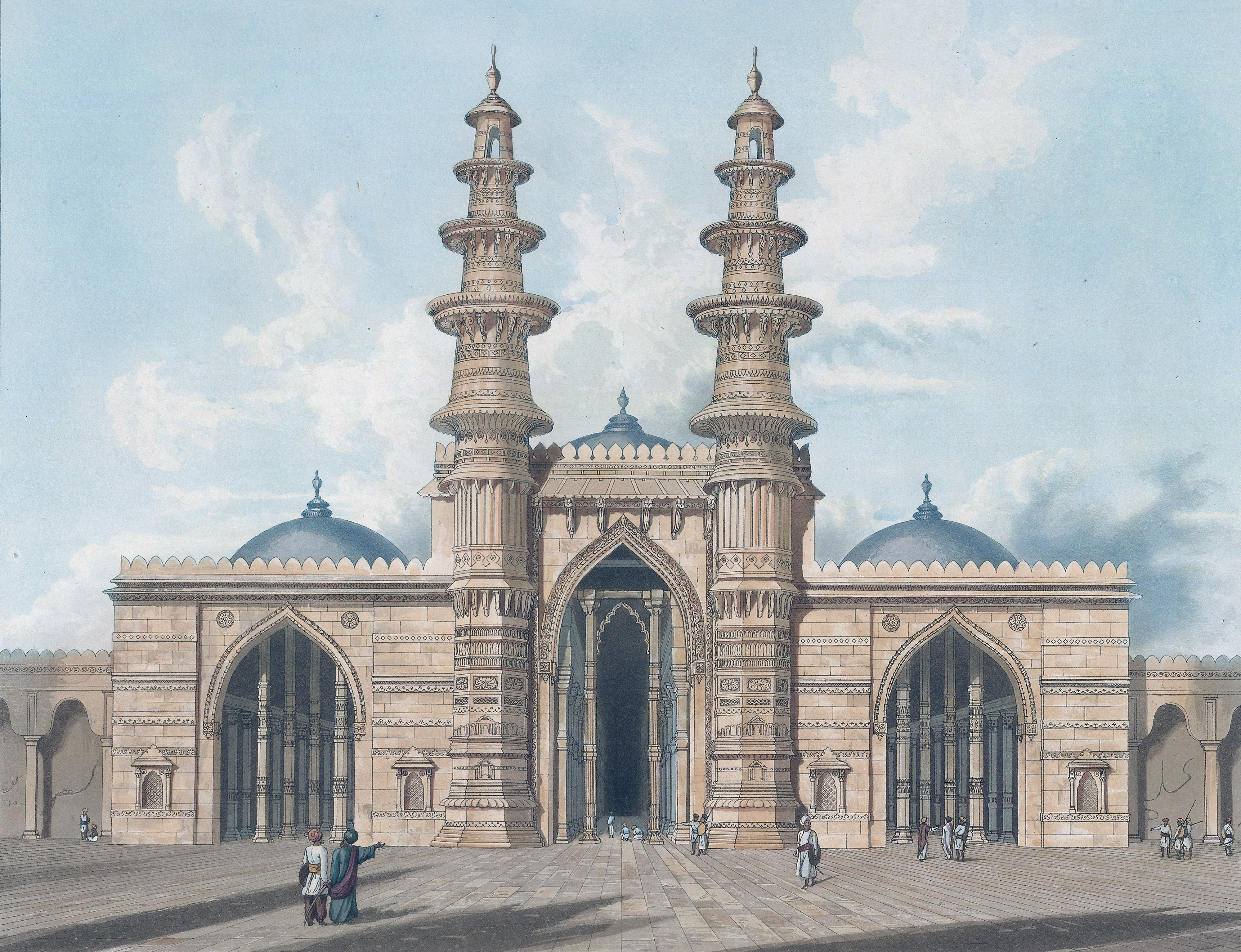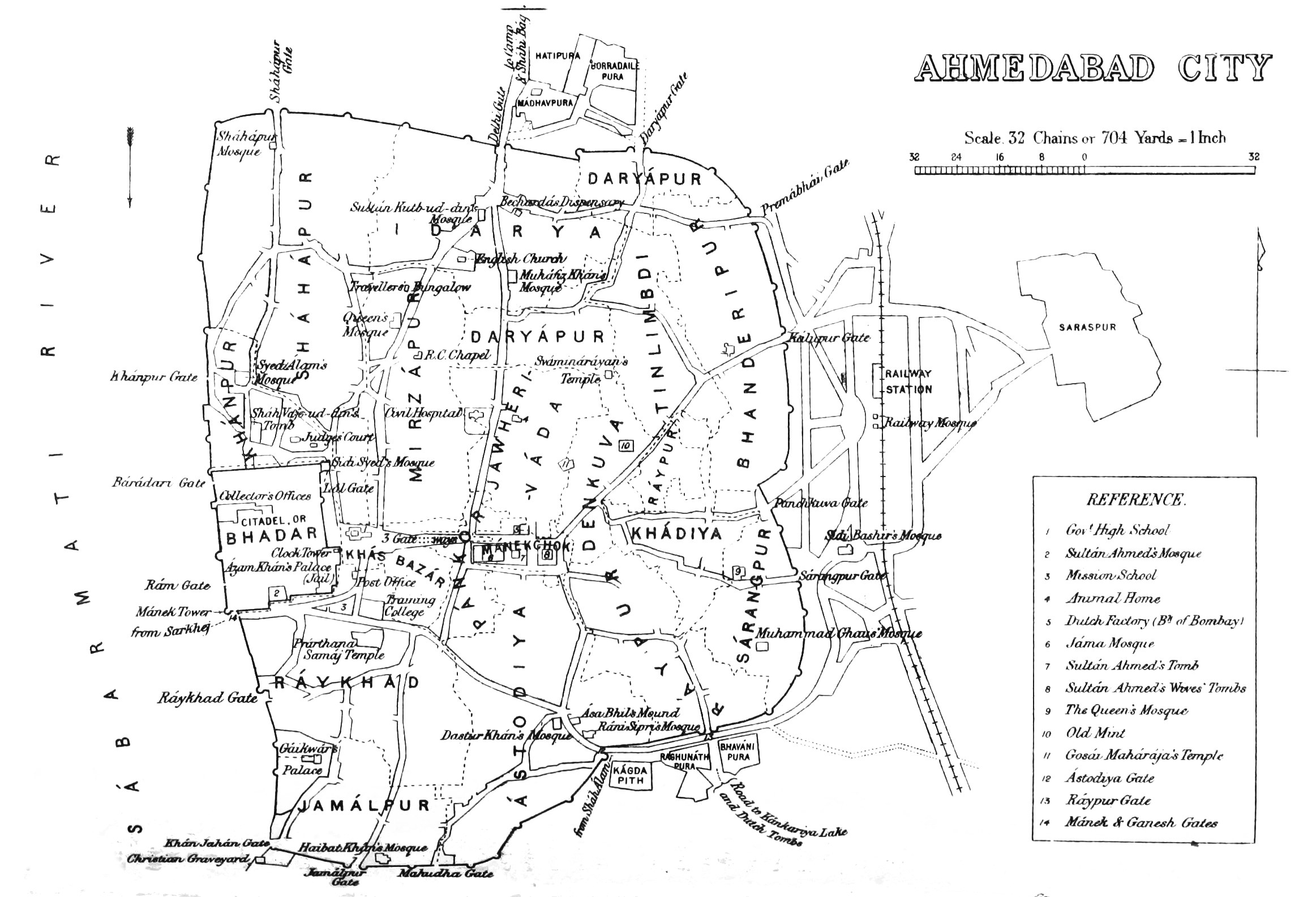|
Dastur Khan's Mosque
Dastur Khan's Mosque, also known as Paththarwali Masjid, is a medieval mosque in Ahmedabad, India. The mosque is located south of Jama Masjid near the Astodiya Gate. The mosque was built in 1486 or 1463 during the reign of Mahmud Begada Sultan Mahmud Begada or Mahmud Shah I (), was the most prominent Sultan of the Gujarat Sultanate. Raised to the throne at young age, he successfully captured Pavagadh and Junagadh forts in battles which gave him his name ''Begada''. He establish ... in the city by Dastur Khan, also known as Malik Khasazada, one of his ministers. The tomb of Dastur Khan is located near the south doorway in an open courtyard within the complex of the mosque. The courtyard walls are decorated with perforated stone windows. Gallery File:Windows Dastur Khan's Mosque Ahmedabad.jpg, Perforated stone windows of the mosque File:Dastur Khan Mosque Ahmedabad Inside 1866.jpg, The colonnade References Mosques in Ahmedabad Monuments of National Importance in Gu ... [...More Info...] [...Related Items...] OR: [Wikipedia] [Google] [Baidu] |
Ahmedabad
Ahmedabad ( ; Gujarati: Amdavad ) is the most populous city in the Indian state of Gujarat. It is the administrative headquarters of the Ahmedabad district and the seat of the Gujarat High Court. Ahmedabad's population of 5,570,585 (per the 2011 population census) makes it the fifth-most populous city in India, and the encompassing urban agglomeration population estimated at 6,357,693 is the seventh-most populous in India. Ahmedabad is located near the banks of the Sabarmati River, from the capital of Gujarat, Gandhinagar, also known as its twin city. Ahmedabad has emerged as an important economic and industrial hub in India. It is the second-largest producer of cotton in India, due to which it was known as the 'Manchester of India' along with Kanpur. Ahmedabad's stock exchange (before it was shut down in 2018) was the country's second oldest. Cricket is a popular sport in Ahmedabad; a newly built stadium, called Narendra Modi Stadium, at Motera can accommodate 132,0 ... [...More Info...] [...Related Items...] OR: [Wikipedia] [Google] [Baidu] |
Islam
Islam (; ar, ۘالِإسلَام, , ) is an Abrahamic religions, Abrahamic Monotheism#Islam, monotheistic religion centred primarily around the Quran, a religious text considered by Muslims to be the direct word of God in Islam, God (or ''Allah'') as it was revealed to Muhammad, the Muhammad in Islam, main and final Islamic prophet.Peters, F. E. 2009. "Allāh." In , edited by J. L. Esposito. Oxford: Oxford University Press. . (See alsoquick reference) "[T]he Muslims' understanding of Allāh is based...on the Qurʿān's public witness. Allāh is Unique, the Creator, Sovereign, and Judge of mankind. It is Allāh who directs the universe through his direct action on nature and who has guided human history through his prophets, Abraham, with whom he made his covenant, Moses/Moosa, Jesus/Eesa, and Muḥammad, through all of whom he founded his chosen communities, the 'Peoples of the Book.'" It is the Major religious groups, world's second-largest religion behind Christianity, w ... [...More Info...] [...Related Items...] OR: [Wikipedia] [Google] [Baidu] |
Gujarat
Gujarat (, ) is a state along the western coast of India. Its coastline of about is the longest in the country, most of which lies on the Kathiawar peninsula. Gujarat is the fifth-largest Indian state by area, covering some ; and the ninth-most populous state, with a population of 60.4 million. It is bordered by Rajasthan to the northeast, Dadra and Nagar Haveli and Daman and Diu to the south, Maharashtra to the southeast, Madhya Pradesh to the east, and the Arabian Sea and the Pakistani province of Sindh to the west. Gujarat's capital city is Gandhinagar, while its largest city is Ahmedabad. The Gujaratis are indigenous to the state and their language, Gujarati, is the state's official language. The state encompasses 23 sites of the ancient Indus Valley civilisation (more than any other state). The most important sites are Lothal (the world's first dry dock), Dholavira (the fifth largest site), and Gola Dhoro (where 5 uncommon seals were found). Lothal i ... [...More Info...] [...Related Items...] OR: [Wikipedia] [Google] [Baidu] |
Ahmedabad Municipal Corporation
The Amdavad Municipal Corporation, or the AMC, established in July 1950 under the Bombay Provincial Corporation Act (1949), is responsible for the civic infrastructure and administration of the city of Ahmedabad. History On 21 April 1831, the collector of the city, Mr. Bordel formed 'Town Wall Fund Committee' comprising the citizens of Ahmedabad with aim of raising fund to repair and renovate the fort of Ahmedabad damaged in floods. The committee levied 1% tax on the sale of various commodities such as ghee. It raised 2 lakh rupees and repaired the fort. The Ahmedabad Municipality was founded in 1873.Cases in Financial Management, 2/E By Pandey & Bhat; pp-7 The British Government nominated Ranchhodlal Chhotalal as the first president of the municipality on 15 September 1885. The republic municipality was formed on 1 April 1915. Bhaishankar Nanabhai was the first elected president of the municipality. Ahmedabad Borough Municipality came into existence in 1925–26. In 1935, th ... [...More Info...] [...Related Items...] OR: [Wikipedia] [Google] [Baidu] |
Indo-Islamic Architecture
Indo-Islamic architecture is the architecture of the Indian subcontinent produced by and for Islamic patrons and purposes. Despite an initial Arab presence in Sindh, the development of Indo-Islamic architecture began in earnest with the establishment of Delhi as the capital of the Ghurid dynasty in 1193. Succeeding the Ghurids was the Delhi Sultanate, a series of Central Asian dynasties that consolidated much of North India, and later the Mughal Empire by the 15th century. Both of these dynasties introduced Persianate architecture and art styles from Western Eurasia into the Indian subcontinent. The types and forms of large buildings required by Muslim elites, with mosques and tombs much the most common, were very different from those previously built in India. The exteriors of both were very often topped by large domes, and made extensive use of arches. Both of these features were hardly used in Hindu temple architecture and other indigenous Indian styles. Both types of ... [...More Info...] [...Related Items...] OR: [Wikipedia] [Google] [Baidu] |
Jama Masjid, Ahmedabad
Jama Masjid (literally Friday Mosque), also known as Jumah Mosque or Jami' Masjid, is a mosque in Ahmedabad, and was built in 1424 during the reign of Ahmad Shah I. The inscription on the central mihrab commemorates the inauguration of the mosque on the 1st Safar A.H. 827 or January 4, 1424 A.D. by Sultan Ahmad Shah I. The mosque lies in the old walled city, and it is situated outside Bhadra Fort area. The old walled city is divided into separate quarters or pols, and the Jami' Masjid is found on the Gandhi Road. Along the south side of the road, the mosque is a short distance beyond the Teen Darwaza or Tripolia Gate. The Jama Masjid was the fifth mosque structure built during Ahmed Shah I's reign. The prior mosques had either been modest in size or were for private use. The Jama Masjid was the complete opposite of its predecessors in that it was a large, grandiose structure. The mosque complex has a large paved courtyard that can be entered from three different directions. Th ... [...More Info...] [...Related Items...] OR: [Wikipedia] [Google] [Baidu] |
Gates Of Ahmedabad
The ''Darwaja'' or Gates of Ahmedabad were built during different times starting from 1411 as the entrances to the walled city of Ahmedabad, Gujarat, India. These entrances to the city has a unique name and history. Pretty much the area surrounding these gates have adopted the name of the gate as the name of the locality. Each of the gate has beautiful carvings, calligraphy and some of them even balconies. History Ahmedabad was founded over the ancient settlement of Ashaval in 1411 by Ahmed Shah I of Gujarat Sultanate. He built the first citadel Bhadra Fort starting from Manek Burj, the first bastion of the city. The Bhadra Fort had eight gates excluding palace gates. When the city expanded, Ahmed Shah built the second fort which was later fortified by Mahmud Begada in 1486. The second fort had twelve major gates and other smaller gates. After arrival of railways, British built two more gates to facilitate the movement. Later the city walls were demolished leaving the gates ... [...More Info...] [...Related Items...] OR: [Wikipedia] [Google] [Baidu] |
Mahmud Begada
Sultan Mahmud Begada or Mahmud Shah I (), was the most prominent Sultan of the Gujarat Sultanate. Raised to the throne at young age, he successfully captured Pavagadh and Junagadh forts in battles which gave him his name ''Begada''. He established Champaner as the capital. He was responsible for the destruction of the Dwarkadhish Temple in Dwarka, Gujarat, one of the Char Dhams considered sacred by Hindus. Names His full name was Abu'l Fath Nasir-ud-Din Mahmud Shah I. He was born Fat'h Khan or Fateh Khan. He titled himself, ''Sultân al-Barr, Sultân al-Bahr'', Sultan of the Land, Sultan of the Sea. Of the origin of Mahmúd's surname Begra or Begarha, two explanations are given in ''Bird’s History of Gujarát'' (p. 202) and ''Mirăt-i-Ahmedi'' (Persian Text, pp. 74): # From his mustachios being large and twisted like a bullock's horn, such a bullock being called Begado. # That the word comes from the Gujaráti ''be'', two, and ''gadh'', a fort, the people giving him ... [...More Info...] [...Related Items...] OR: [Wikipedia] [Google] [Baidu] |
Mosques In Ahmedabad
A mosque (; from ar, مَسْجِد, masjid, ; literally "place of ritual prostration"), also called masjid, is a Place of worship, place of prayer for Muslims. Mosques are usually covered buildings, but can be any place where prayers (sujud) are performed, including outdoor courtyards. The first mosques were simple places of prayer for Muslims, and may have been open spaces rather than buildings. In the first stage of Islamic architecture, 650-750 CE, early mosques comprised open and closed covered spaces enclosed by walls, often with minarets from which Adhan, calls to prayer were issued. Mosque buildings typically contain an ornamental niche (''mihrab'') set into the wall that indicates the direction of Mecca (''qiblah''), Wudu, ablution facilities. The pulpit (''minbar''), from which the Friday (jumu'ah) sermon (''khutba'') is delivered, was in earlier times characteristic of the central city mosque, but has since become common in smaller mosques. Mosques typically have Isl ... [...More Info...] [...Related Items...] OR: [Wikipedia] [Google] [Baidu] |

.jpg)




